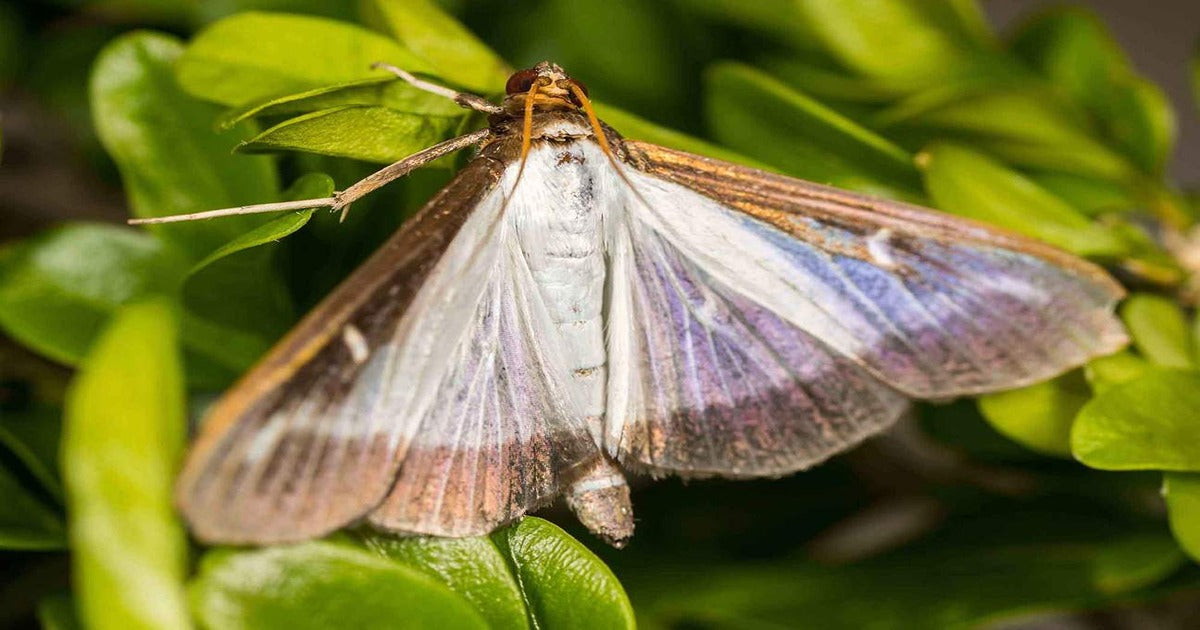
Dragonfli's Three-Step Strategy To Combat The Entire Box Tree Moth Life Cycle
Box Tree Moths overwinter as caterpillars that hide deep inside the Box Plant foliage. As temperatures warm, the caterpillars will pupate and transform into moths. The female moths will proceed to mate and begin laying eggs in little clusters on Box tree plants. These eggs will then hatch into the damaging caterpillars that devastate and kill Box plants and hedges.
Dragonfli are on hand to help, however, and can now provide natural solutions against all three stages of the Box Tree Moth life cycle!

Box Tree Caterpillars feed on Box plants and hedges and are capable of killing Buxus entirely if left untreated.
Stage 1: Catch Adult Box Tree Moths With Pheromone Traps To Reduce Egg Laying
The first step to take in combating Box Tree Moths is to set up your Box Tree Moth Pheromone Traps. These traps will catch male Box Tree Moths and prevent them from mating with females. The traps will also provide you with a valuable early warning of Box Tree Moth activity.
Our Box Tree Moth Pheromone Traps are the first key component in the three pronged attack against Box Tree Moth infestations.
Box Tree Moths have 2-3 generations a year, so it is good practice to keep your Box Tree Pheromone Traps active all spring and summer. Each pheromone lure lasts about six weeks, after which it should then be replaced. You can find replacement lures by clicking here.
Pheromone traps used solely will not catch enough Box Tree Moths to prevent entire infestations, so please be sure to also follow the next steps.

Box Tree Moths are identifiable with white coloured wings bordered by brown. They have a wingspan of roughly 4cm.
Stage 2: Use Trichogramma Parasitic Wasps To Kill Box Tree Moth Eggs
Once Box Tree Moths are observed, it won’t be long before egg laying takes place. These eggs can now be controlled, however, by tiny parasitic wasps contained in small sachets that are placed within Box tree plant foliage. The Trichogramma evanescens parasitic wasps that emerge from our Box Tree Moth Egg Killer Sachets will search the Box tree plants for Box Tree Moth eggs. Once located, the Box Tree Moth eggs are parasitised and killed. The eggs then, instead of producing Box Tree Caterpillars, release new Trichogramma wasps to locate and kill more Box Tree Moth eggs!

Our Box Tree Moth Egg Killer Sachets can be harnessed to kill Box Tree Moth eggs lain by the female Box Tree Moths that were able to mate.
The sachets will continue to release the Trichogramma wasps for up to 4 weeks. We suggest placing one sachet every 5 linear metres of Box hedging, or 1 sachet every 10 square metres. If you have large individual Box tree plants, one sachet can be applied to each plant.

Box Tree Moth eggs are often hidden, and quite difficult to spot with the human eye but don't worry our Trichogramma wasps will be able to find and kill them for you!
Stage 3: Apply Nematodes Directly Onto Box Tree Caterpillars
If Box Tree Caterpillars are observed on Box plants, apply our Box Tree Caterpillar Killer Nematodes directly onto the caterpillars. Only apply the nematodes if caterpillars are present. More than one application may be required, which is why two sachets of nematodes are included in Box Tree Caterpillar Killer. Apply the first sachet when Box Tree Caterpillars are identified, and apply the second sachet about a week later.

Simply spray our Box Tree Caterpillar Killer directly onto the caterpillars and the nematodes will enter the pest via a natural opening, before killing the caterpillars from inside.
Make sure unopened nematode sachets are stored in a fridge to keep them fresh, and avoid applying nematodes on bright, sunny days, as nematodes are U.V sensitive. The optimum conditions for applying nematodes are warm, overcast, humid days. Alternatively, simply apply the nematodes early, or late on in the day.

Box Tree Caterpillars can grow up to 30mm in length and are a greenish-yellow colour. They can be concealed within webbing spun around buxus plants.
Enjoy Renewed Box Plant Growth

These three natural solutions combine to provide a complete biological control of Box Tree Moths and protect your valuable Box Hedges and plants from this devastating pest.
If looking to provide your Box plants with a further aid to recovery, consider also applying our Soil Boost biostimulant granules.
Soil Boost acts as an organic slow release fertiliser, helping the Box plants achieve newly invigorated growth after stress and damage.
If you ever need any further advice on how to combat Box Tree Moths feel free to get in touch via email at sales@dragonfli.co.uk, via social media, or by giving us a call on 01376 563322, and we’d be happy to assist.
Comments (Responses)
Julian Ives
Hi David,
Thanks for getting in touch.
I am sorry to hear of your infestation and regret to inform you that since we do not advise the use of chemical insecticides here at Dragonfli we would be unable to recommend any immediate follow up treatment for you. As you have sprayed your hedges repeatedly with the chemicals our biological controls would be incompatible with these insecticides if applied soon after.
If you wish to give our natural controls a go, including our Box Tree Caterpillar Killer Nematodes and Box Tree Moth Egg Killer Sachets, then I would suggest you wait until next season and apply them before, or ideally instead of, any chemical sprays.
If you need any further information on our products or advice on how best to apply them please feel free to get in touch and we’ll be happy to assist.
Kind regards, Julian Ives [Director, Dragonfli]
David Lee
Hi there, I have box trees, spirals, balls , and hedges all around my property that is roughly 1 acre and suddenly I noticed the die back and started investigating what was wrong. One of my hedges about 100 feet long on one side was fine but then I looked at the rear and what a mess ! I got the hosepipe out and watered it as it looked dry and then I saw the moths coming out of it and looked on line and treated it with bug 2 which worked to a degree gave it 3 treatments but I still had a few moths. The hedge fortunately started to regrow and I used a different treatment which seems better but has not got rid of them all !! The reason for my message is due to the fact I have so many boxes at my home it cost a small fortune in treatments that I simply cannot afford, is there a larger quantity that is a bit cheaper buying in bulk. Many thanks Dave
Julian Ives
Hi Rosemary,
Many thanks for getting in touch.
I’m sorry to hear that you had to lose a box hedge to the caterpillars, hopefully the infestation on the larger box has been minimised with the aid of the pheromone traps.
Indeed temperatures are quickly cooling and we expect the moths to stop flying at the end of this month. This will then make the use of active traps unnecessary until the Spring, as you rightly acknowledge.
In answer to your queries, the eggs will not remain dormant over the winter but the caterpillars will overwinter. It would be best, therefore, that you bin all of the infested branches, with some caterpillars hopefully then disposed of, and remove as much foliage as possible to eliminate overwintering locations for the caterpillars.
I hope this helps but please just let us know if you require any further advice.
Kind regards, Julian Ives [Director, Dragonfli]
Rosemary Bradley
We had a small box hedge totally devastated by box caterpillars. We removed hedge.
We have a 30’ high box tree nearby with some infestation in lower branches. I have successfully placed 2 pheromone traps & replaced lures as instructed for several months. I will stop using pheromone soon as weather cools & recommence in April.
We have cut branches of infected leaf nearby. Do eggs lie dormant over winter & should we bin all cut infected branches?
Thank you for any suggestions.







31 October, 2023
Robert
Not sure which killer is at work but my box hedge and trees are suffering with leaves died out in patches. It is November now – what can you recommend?